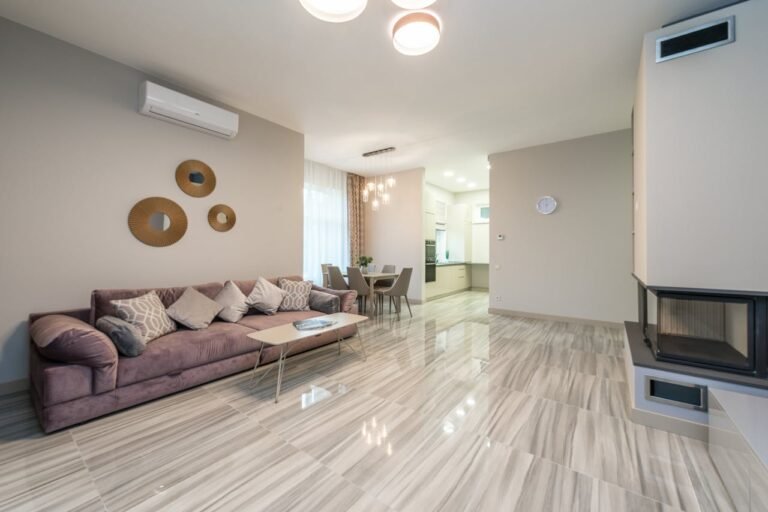Types of Flooring for Your Home
Flooring is a permanent covering over the floor structure with a finish material to provide a walking surface, and it is one of the first things noticed when entering a house. Choosing between different flooring options is a crucial aspect during a renovation or construction, with various factors to be considered, such as cost, durability, appearance, installation, and maintenance. Depending on the characteristics and needs of each room, one type of flooring may be more suitable than another, requiring different properties like moisture tolerance, slip resistance, or scratch resistance, and even providing warmth and tactility.
Key Characteristics of Good Quality Flooring
• Durable: Long-lasting and resistant to wear.
• Easy to Clean: Simple to maintain and hygienic.
• Quiet: Minimizes walking noise.
• Attractive: Enhances the space’s aesthetics.
• Moisture Resistant: Prevents damage from dampness.
• Temperature & Fire Resistant: Offers safety and comfort.
• Cost-Effective: Reasonable initial and maintenance costs.
• Hard & Smooth: Resists damage and provides comfortable walking.
• Insulating: Offers sound and thermal benefits.
12 Types of Flooring Materials to Consider for Your Home
1. Hardwood Flooring
 Hardwood flooring is a classic and highly desirable option prized for its natural beauty, durability, and timeless appeal. Made from various wood species like oak, maple cherry, and walnut, it adds warmth and elegance to any home. Properly maintained, hardwood floors can last for decades and even increase a home’s value. While versatile in style and finish, they are best suited for dry areas of the house. Installation typically involves securing planks to a subfloor and finishing with sanding and sealing.
Hardwood flooring is a classic and highly desirable option prized for its natural beauty, durability, and timeless appeal. Made from various wood species like oak, maple cherry, and walnut, it adds warmth and elegance to any home. Properly maintained, hardwood floors can last for decades and even increase a home’s value. While versatile in style and finish, they are best suited for dry areas of the house. Installation typically involves securing planks to a subfloor and finishing with sanding and sealing.
Hardwood flooring advantages
• Timeless Appeal: Adds natural beauty, warmth, and elegance to any space.
• Variety of Styles: Available in diverse wood species, colors, and finishes.
• Excellent Durability: Withstands heavy use and can last for decades.
• Potential Value Increase: Often boosts a home’s resale value.
• Easy Maintenance: Simple to clean and maintain a hygienic environment.
• Refinishable (Solid Wood): Surface can be sanded and refinished to restore its look.
• Improved Air Quality: Doesn’t trap allergens like some other flooring types.
• Versatile Options: Engineered and waterproof versions offer more installation flexibility and moisture resistance.
Hardwood flooring disadvantages
• Higher Initial Cost: Generally more expensive than laminate or vinyl.
• Susceptible to Moisture: Can be damaged by water and humidity.
• Prone to Scratches and Dents: Can be marked by heavy objects or sharp items.
• Can Be Noisy: Foot traffic can generate more sound compared to softer options.
• Temperature Sensitive: Solid wood can expand and contract with temperature fluctuations.
• Refinishing Can Be Disruptive: The process is time-consuming and may require temporary relocation.
• Limited Refinishing (Engineered Wood): The thinner top layer may limit the number of times it can be refinished.
• Can Feel Cold: Doesn’t retain heat as well as some other flooring materials.
2. Tile Flooring
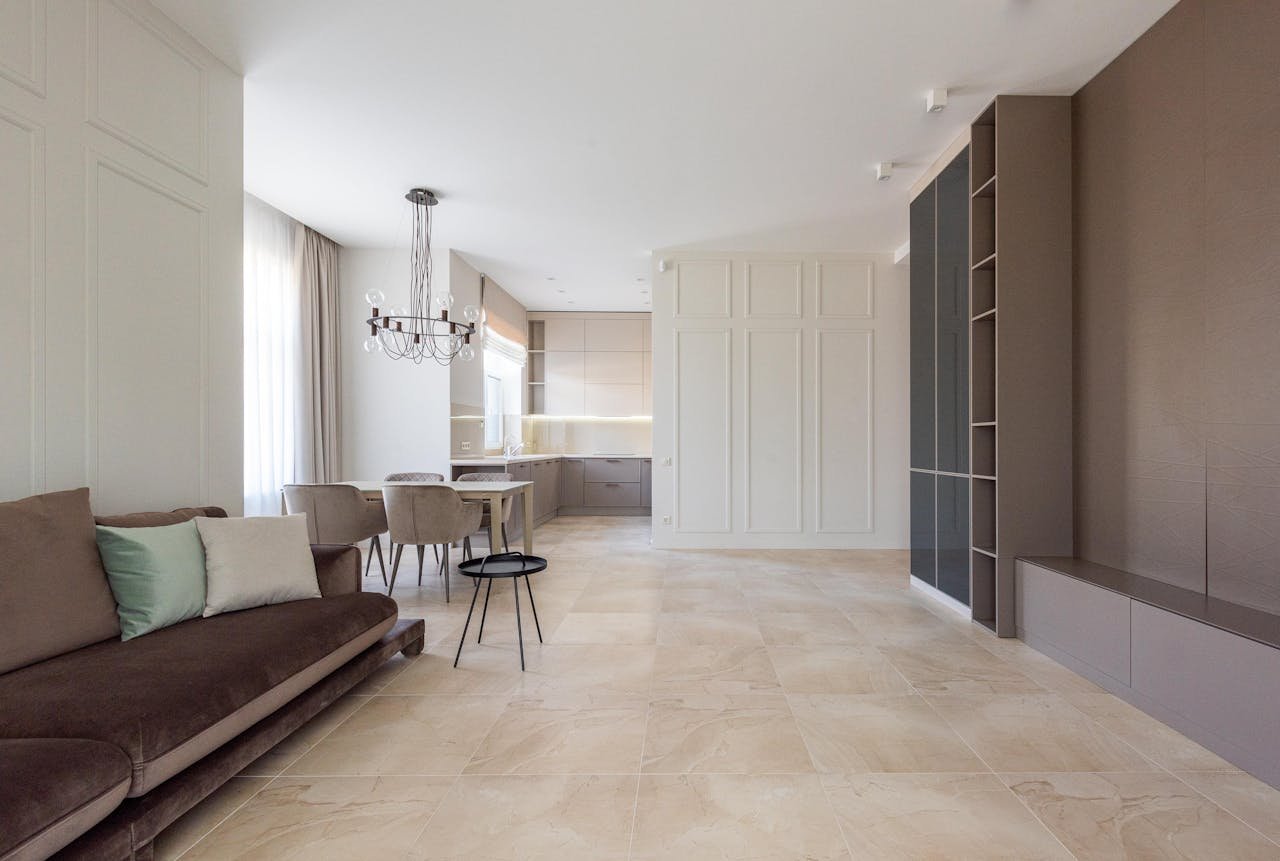
Tile flooring is a durable and versatile choice for homes, offering a wide range of styles for any room, including moisture-prone areas like bathrooms and kitchens. Common types include ceramic and porcelain, with porcelain being denser and more water-resistant. While easy to clean and maintain, grout requires regular upkeep, and the surface can be slippery when wet. Installation involves adhering tiles to a prepared subfloor and finishing with grout.
Tile flooring advantages
• Exceptional Durability: Known for its strength and longevity, lasting for many years.
• Water Resistance: Ideal for moisture-prone areas like bathrooms and kitchens.
• Easy to Maintain: Simple to clean and resistant to stains.
• Style Versatility: Available in a wide array of shapes, sizes, colors, and patterns.
• Hypoallergenic: Does not harbour allergens, promoting better indoor air quality.
• Indoor/Outdoor Use: Suitable for various applications throughout and around the home.
Tile flooring disadvantages
• Hard and Uncomfortable: Can be tiring for prolonged standing or walking.
• Cold Surface: Does not retain warmth well, which can be uncomfortable in colder climates.
• Professional Installation Recommended: Requires specific skills for proper fitting and longevity.
• Susceptible to Cracking: Can chip or crack under heavy impact.
• Grout Maintenance: Requires regular cleaning and sealing to prevent staining and mildew.
• Higher Initial Cost: Generally more expensive than some other flooring options.
• Slippery When Wet: Can pose a slip hazard if not properly textured or treated.
3. Vinyl Flooring
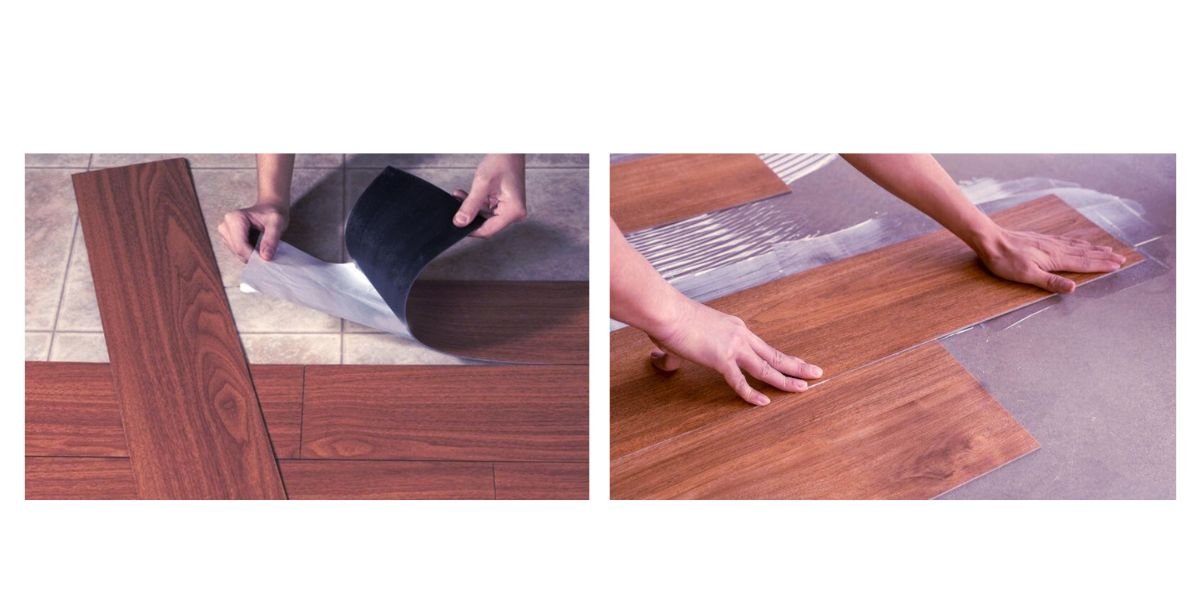
Vinyl flooring, also known as PVC flooring, is a cost-effective and durable synthetic option known for its water and stain resistance. Available in various styles mimicking wood and stone, it’s ideal for moisture-prone areas like kitchens and bathrooms. It’s easy to clean and comes in sheets, planks, or tiles for different installation methods. While relatively long-lasting, it’s susceptible to scratches and cannot be refinished. A key drawback is its lack of fire resistance. Quality can vary between manufacturers.
Vinyl flooring advantages
• Affordable: Generally a budget-friendly flooring option.
• Water-Resistant: Excellent for kitchens, bathrooms, and other damp areas.
• Style Variety: Available in numerous designs mimicking wood, stone, and tile.
• Easy to Maintain: Simple to clean and resistant to stains.
• DIY-Friendly Installation: Many types offer easy, floating installation.
• Comfortable Underfoot: Softer and warmer than tile or hardwood.
• Good Insulation: Provides some insulation against cold and heat.
• Durable: Resilient and can withstand moderate foot traffic.
Vinyl flooring disadvantages
• Susceptible to Damage: Can be gouged, cut, or torn by sharp objects or heavy dragging.
• Fading: Color can fade with prolonged exposure to direct sunlight.
• Limited Repairs: Damage often requires full replacement rather than repair.
• Shorter Lifespan: Generally doesn’t last as long as hardwood or tile.
• Environmental Concerns: Manufacturing can involve toxic chemicals and energy-intensive processes.
• Non-Recyclable: Typically cannot be recycled due to adhesives and composition.
• Heat Sensitivity: Can be damaged by high heat.
• Less Luxurious Feel: Doesn’t have the same high-end feel as natural materials.
4. Concrete Flooring

Concrete flooring is a durable and cost-effective option suitable for various settings, from industrial to residential. Made from cement and aggregates, it’s easy to maintain and can be customized with stains and finishes. While long-lasting and resistant to damage, repairs can be noticeable. Polished concrete offers additional benefits like being non-toxic and energy-efficient, though its production has a significant carbon footprint.
Concrete flooring advantages
• Exceptional Durability: Can last for decades with proper care, suitable for high-traffic areas.
• Low Maintenance: Easy to clean and generally stain-resistant when sealed.
• Versatile Design: Customizable with various finishes, colors, and textures.
• Energy Efficient: Absorbs and releases heat, potentially reducing heating and cooling costs.
• Long-Term Cost-Effective: Reduced need for replacement and repairs over time.
• Good Air Quality: Doesn’t harbour allergens like some other flooring types.
• Suitable for Radiant Heat: Works well with underfloor heating systems.
• Utilizes Abundant Resources: Made from readily available materials and can incorporate waste by-products.
Concrete flooring disadvantages
• Environmental Impact: Manufacturing process has a significant carbon footprint.
• Hard and Cold: Can be uncomfortable for prolonged standing and feels cold underfoot.
• Susceptible to Cracking: Can crack due to temperature changes or improper installation.
• Installation Labour: Often requires professional installation, which can be labour-intensive.
• Potential for Toxic Additives: Colorizing agents used in some finishes can be harmful.
• Noticeable Repairs: Repairs may not always blend seamlessly with the existing floor.
• Heavy Material: Requires a strong subfloor structure to support its weight.
5. Carpet Flooring
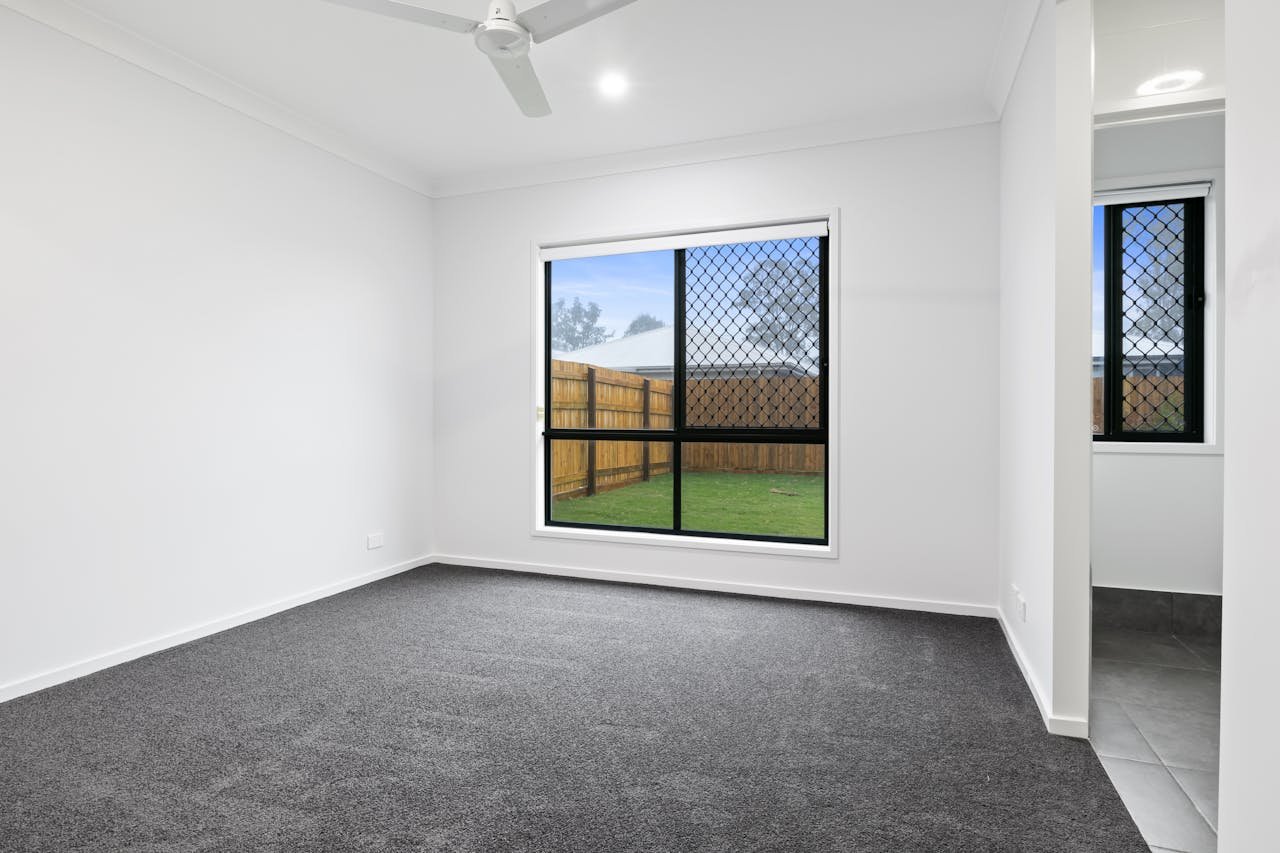
Carpet flooring features a soft, comfortable pile made from natural (like wool) or synthetic fibers attached to a backing. It offers warmth, sound insulation, and a wide range of styles and colors, making it popular for bedrooms and living areas. While cozy underfoot, it requires regular cleaning and can trap allergens. Installation is typically professional. Environmentally, conventional carpets are often not biodegradable or easily recycled and may contain harmful chemicals, though natural options exist.
Carpet flooring advantages
• Comfortable & Soft: Provides a cushioned and pleasant surface underfoot.
• Warm & Cozy: Offers insulation and warmth, especially in colder climates.
• Noise Reduction: Absorbs sound, creating a quieter environment.
• Variety of Styles: Available in a wide range of colors, textures, and constructions.
• Non-Slip: Offers better traction compared to hard surfaces.
• Sustainable Options (Wool): Certain natural wool carpets are renewable and can improve air quality.
• Durable (Certain Types): High-quality carpets, especially wool, can be long-lasting.
• Potentially Washable (Newer Types): Some innovative carpets offer easy cleaning.
Carpet flooring disadvantages
• Stain Susceptibility: Can be difficult and costly to clean if spills occur.
• Allergen Retention: Traps dust, pet dander, and other allergens, requiring regular cleaning.
• Wear and Tear: High-traffic areas show wear more quickly.
• Moisture Retention: Can absorb and retain moisture, leading to potential mildew growth.
• Environmental Concerns: Many synthetic carpets are not easily recyclable and may contain harmful chemicals.
• Cost (Wool): Natural wool carpets can be significantly more expensive than synthetic options.
• Insect Attraction: Can be prone to attracting insects if not properly maintained.
• Manufacturing Impact: The production process can have a carbon footprint.
6. Laminate Flooring
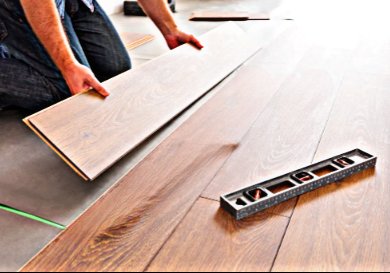
Laminate flooring is a cost-effective synthetic option that mimics the look of wood, stone, or tile through a photographic layer. It’s known for its durability, water and stain resistance, and easy click-and-lock installation, making it DIY-friendly. While affordable and stylish, it cannot be refinished and its manufacturing involves chemicals like formaldehyde, raising environmental and health concerns. Look for certifications regarding formaldehyde emissions and water resistance when choosing laminate.
Laminate flooring advantages
• Affordable Alternative: Provides the look of wood, tile, or stone at a lower cost.
• Durable Surface: Resistant to scratches, stains, fading, and general wear.
• Easy Installation: Often features a click-and-lock system for simple DIY.
• Low Maintenance: Simple to clean and requires minimal upkeep.
• Versatile Designs: Available in a wide variety of realistic styles and colors.
• Moisture Resistance (Good Quality): Offers better resistance than hardwood in damp areas.
• Hypoallergenic: Doesn’t trap allergens as easily as carpet.
• Temperature and Pressure Resistant: Holds up well to changes in environment.
Laminate flooring disadvantages
• Cannot Be Refinished: Damage requires full replacement of planks.
• Potential Water Damage (Lower Quality): Can be susceptible to swelling and damage from excessive moisture.
• Less Authentic Feel: Doesn’t have the same natural look and feel as real wood or stone.
• Can Be Noisy: May produce a hollow sound when walked upon.
• Environmental Concerns: Manufacturing uses chemicals like formaldehyde and is energy-intensive.
• Not Fully Biodegradable: The top layer is not easily broken down.
• Lower Resale Value: Generally doesn’t add as much value to a home as natural hardwood.
• Lifespan Limitation: Typically lasts between 10-30 years.
7. Cork Flooring
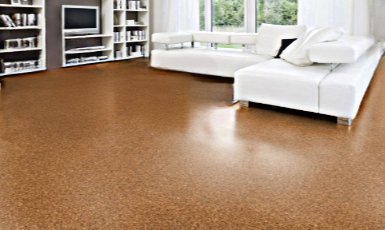
Cork flooring is a sustainable and comfortable option made from the bark of cork oak trees. It’s known for being quiet underfoot, visually warm, and having natural anti-allergen and insulating properties. Available in tiles or planks, it’s relatively easy to maintain but can be dented by heavy furniture. While eco-friendly in harvesting and production, its primary sourcing in Europe can increase its overall carbon footprint in other regions.
Cork flooring advantages
• Comfortable & Quiet: Soft underfoot and absorbs sound effectively.
• Eco-Friendly: Sustainable harvesting and low-waste production.
• Hypoallergenic: Naturally resists mold, mildew, and allergens.
• Insulating: Provides both thermal and acoustic insulation.
• Insect Repellent: Naturally deters insects.
• Variety of Styles: Available in different looks to suit various designs.
• Cost-Effective (Compared to Wood): Generally less expensive than hardwood.
• Sustainable Installation: Often installed without toxic adhesives.
Cork flooring disadvantages
• Moisture Sensitive: Can warp or damage in high humidity or wet areas.
• Less Durable: More prone to scratches, dents, and pet damage than harder floors.
• Fading: Color can fade with prolonged sun exposure.
• Requires Maintenance: Needs regular sealing to protect the surface.
• Shorter Lifespan: Typically lasts 10-30 years, less than some other options.
• Transportation Costs: Primarily sourced from Europe, increasing its carbon footprint in other regions.
• Potential Warping: Best suited for stable humidity levels.
8. Brick Flooring

Brick flooring is a durable and cost-effective option known for its strength and fire resistance. Suitable for both indoor and outdoor use, including high-traffic areas like warehouses and rustic residential spaces, it offers a non-slip surface and various design possibilities. Installation involves laying bricks in mortar over a concrete subgrade, with proper curing required. While easy to clean, its porous nature necessitates maintenance to prevent chipping.
Brick flooring advantages
• Highly Durable: Long-lasting and resistant to wear, tear, and fire.
• Unique Aesthetic: Offers a rustic, timeless appeal that can improve with age.
• Cost-Effective (Material): Brick pavers can be an affordable flooring option.
• Good Temperature Retention: Stays relatively warm underfoot, good for colder climates.
• Versatile Application: Suitable for both indoor and outdoor use.
• Easy Maintenance (Sealed): Simple to clean and maintain once properly sealed.
• Non-Allergenic: Doesn’t typically harbour allergens.
• Non-Slip: Provides good traction for safety.
• Design Flexibility: Many patterns and colors available for customization.
• Environmentally Friendly: Made from natural and often recyclable materials.
Brick flooring disadvantages
• Hard and Uncomfortable: Can be tiring to stand on for long periods.
• Stain Susceptibility (Unsealed): Porous and can easily absorb stains and moisture.
• Requires Sealing: Essential to protect against stains, moisture, and fungal growth.
• Can Feel Cold: May be cold underfoot, especially in colder climates if not insulated.
• Heavy Material: Can add significant weight, potentially limiting use on upper floors.
• Installation Labour: Can be labour-intensive and may require professional installation.
• Potential for Unevenness: Achieving a perfectly level surface can be challenging.
• Surface Erosion (Unsealed): Some bricks may degrade over time if not protected.
9. Linoleum Flooring

Linoleum is an eco-friendly flooring made from natural materials like linseed oil and cork dust. It’s a versatile and affordable option known for its comfort underfoot and resistance to water, grease, and fire. Available in various designs and typically glued down, modern versions may offer floating installation. While sustainable in its materials, its manufacturing has a higher carbon footprint and can release VOCs. It’s less durable than vinyl and prone to scratches and dents.
Linoleum flooring advantages
• Eco-Friendly: Made from natural, biodegradable, and recyclable materials.
• Durable Over Time: Becomes stronger and more resilient with age.
• Water & Fire Resistant: Suitable for kitchens and areas with potential spills.
• Comfortable Underfoot: Offers a cushioning effect for walking and standing.
• Variety of Styles: Available in many colors and patterns for diverse aesthetics.
• Antimicrobial: Naturally inhibits the growth of microbes.
• Resistant to Certain Chemicals: Not damaged by fats, oils, and organic solvents.
• Long Lifespan: Can last for up to 40 years.
Linoleum flooring disadvantages
• VOC Emissions: Manufacturing releases volatile organic compounds.
• Odor Concerns: Can emit a strong smell, especially during installation and initially.
• Prone to Indentations: Heavy furniture and sharp objects can leave marks.
• Staining Potential: Can stain if spills are not cleaned promptly.
• Moisture Sensitivity (Subfloor): Rancid odor can develop if installed over damp subfloors.
• Fading in Sunlight: Color may darken with prolonged UV exposure.
• Installation Requirements: Needs proper subfloor and adhesives, with heat welding for seams.
• Energy-Intensive Production: Manufacturing process has a high energy consumption.
10. Rubber Flooring
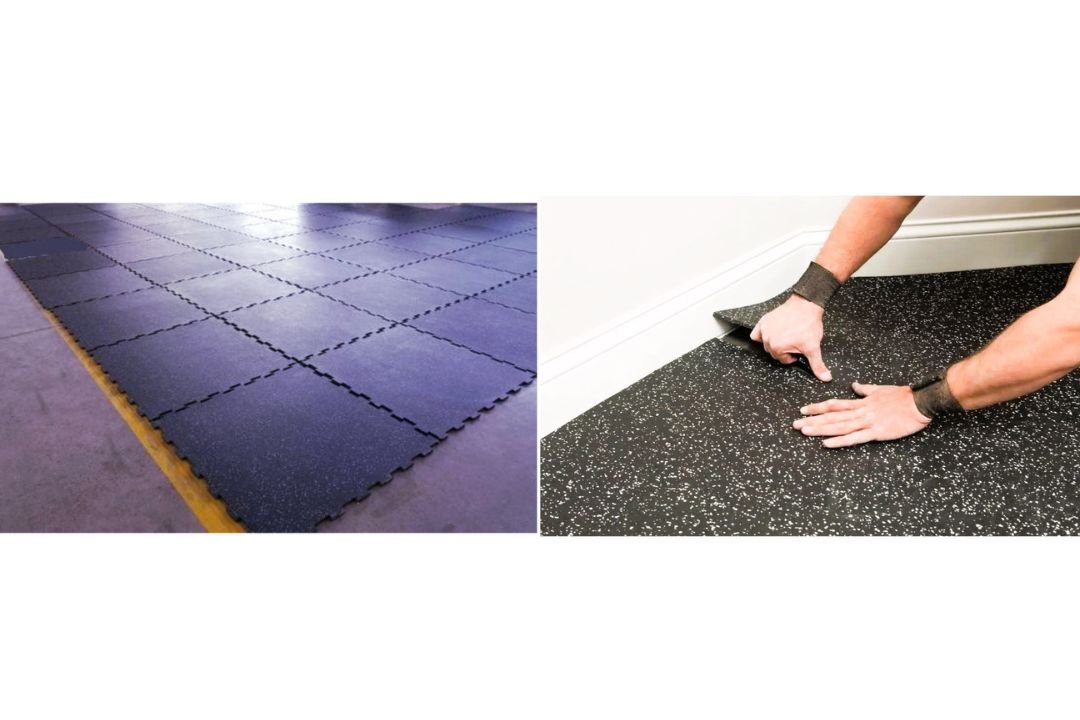
Rubber flooring is a resilient and versatile option made from natural or synthetic rubber, often recycled. Its elasticity provides comfort and slip resistance, making it suitable for high-traffic areas, gyms, and playrooms. It offers moisture and stain resistance, sound absorption, and durability. Available in rolls or interlocking tiles, it’s installed with adhesive or by interlocking.
Rubber flooring advantages
• Highly Durable: Withstands heavy use and resists damage like scratches and dents.
• Comfortable: Elasticity provides cushioning and reduces foot fatigue.
• Sound Absorbing: Dampens noise and reduces impact sounds.
• Water-Resistant: Suitable for areas prone to moisture like bathrooms and kitchens.
• Slip-Resistant: Enhances safety by providing good traction.
• Low Maintenance: Easy to clean with simple sweeping and wiping.
• Hypoallergenic: Resists mold, mildew, and bacteria, good for allergy sufferers.
• Variety of Styles: Available in various colors, patterns, and textures.
• Fire-Resistant: Offers a degree of safety in case of fire.
• Eco-Friendly (Recycled Options): Can be made from recycled materials.
Rubber flooring disadvantages
• Higher Cost: Generally more expensive than vinyl or laminate.
• Limited Design Options: Fewer aesthetic choices compared to other flooring types.
• Staining Potential: Can be stained by oil-based or acidic substances.
• Indentation from Heavy Items: Heavy furniture can leave permanent marks.
• Distinct Odor: Some rubber can have a noticeable smell, especially when new.
• Not Universally Appealing: The look and feel of rubber may not suit all design styles.
11. Terrazzo Flooring
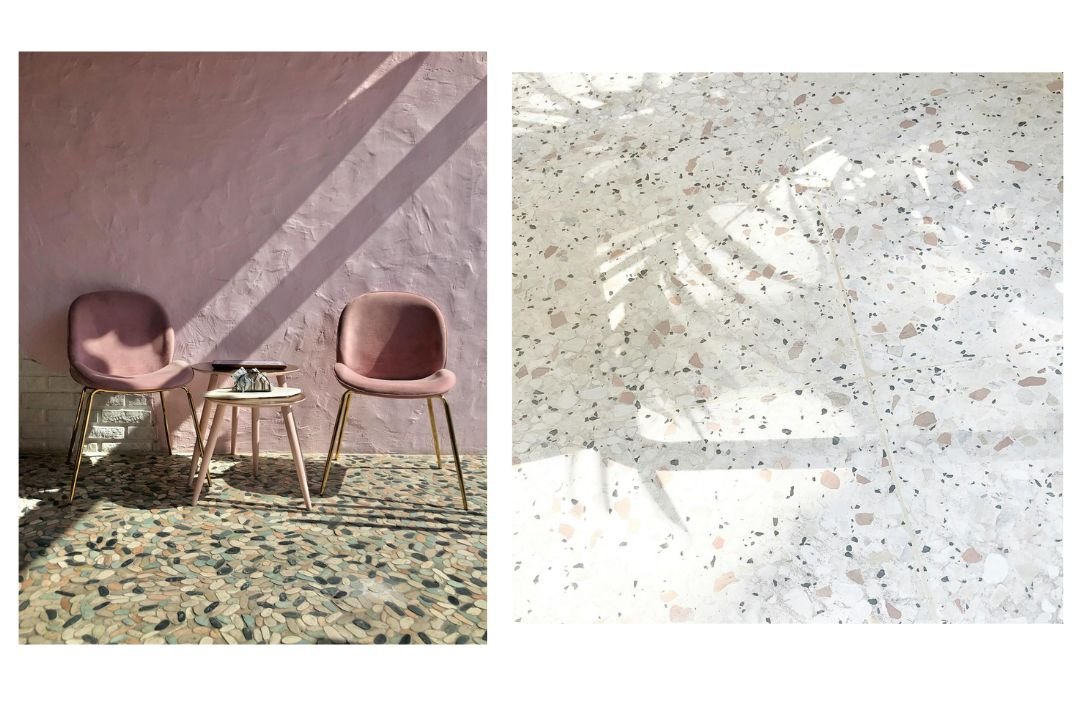
Terrazzo flooring is a durable and visually appealing material made by embedding chips of marble, granite, glass, or other aggregates into a binder like concrete or epoxy. It offers a smooth, often polished surface and is known for its speckled appearance. Traditionally used in commercial settings, it’s gaining popularity in homes for its unique look and longevity. Installation requires skilled labour.
Terrazzo flooring advantages
• Exceptional Durability: Highly resistant to wear, tear, stains, and water damage, ideal for high-traffic areas.
• Long Lifespan: Can last for decades with proper maintenance.
• Low Maintenance: Easy to clean with regular sweeping and mopping.
• Limitless Design Options: Customizable with a wide range of colors and aggregates.
• Eco-Friendly: Can incorporate recycled materials and VOC-free binders.
• Water and Stain Resistant (Sealed): Impervious to water damage when properly sealed.
• Can Be Refinished: Worn surfaces can be polished to look new.
• Versatile Applications: Suitable for both indoor and outdoor use.
Terrazzo flooring disadvantages
• Slippery When Wet: Polished surfaces can be hazardous when wet.
• Hard and Uncomfortable: Lacks cushioning and can be tiring to stand on for extended periods.
• High Initial Cost: More expensive to install compared to some other flooring options.
• Requires Professional Installation: Improper installation can lead to problems.
• Cold Surface: Doesn’t retain heat well, feeling cold underfoot.
• Potential for Cracking: Improper installation or building movement can cause cracks.
12. Stone Flooring
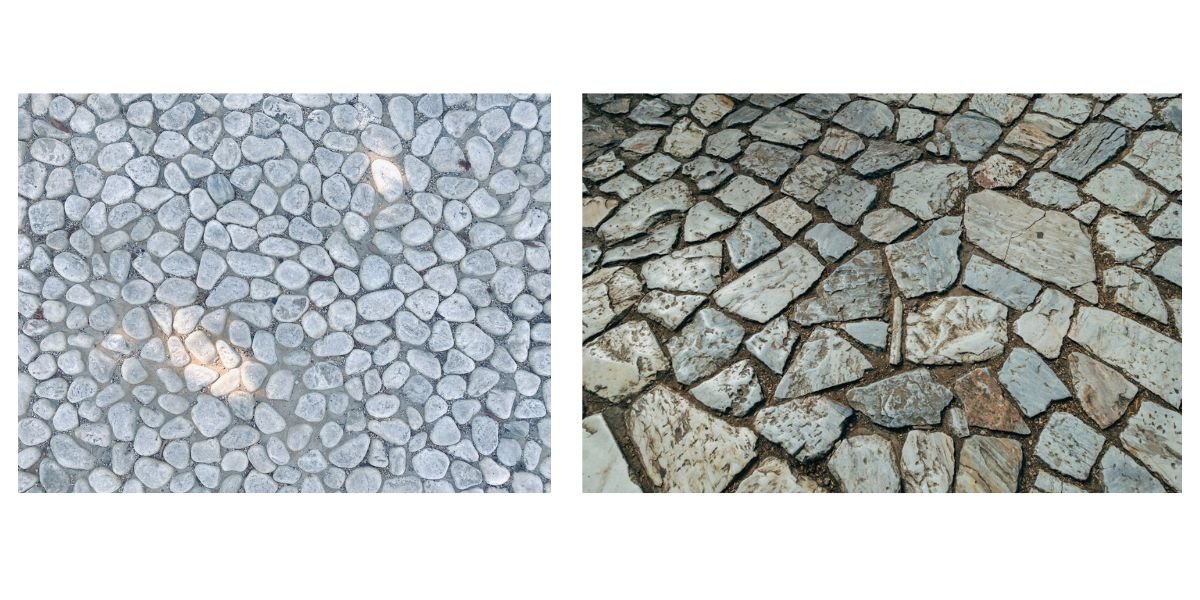
Stone flooring refers to floors made from natural materials like marble, granite, slate, and limestone. It’s known for its durability, hardness, and varied aesthetic, ranging from polished elegance to a more natural, unpolished look. Installation involves setting the stones with adhesive and finishing with grout and sealant. While long-lasting, stone flooring often has a higher cost and more complex installation compared to other options.
Stone flooring advantages
• Timeless Beauty: Offers a natural and elegant aesthetic with unique variations.
• Exceptional Durability: Highly resistant to wear and can last for a very long time.
• Variety of Options: Many stone types (marble, granite, slate, etc.) with different looks and properties.
• Low Maintenance: Generally easy to clean and maintain once properly sealed.
• Natural Cooling: Can help keep interiors cooler in warm climates.
• Non-Slip Options: Some stones, like sandstone, offer good traction.
Stone flooring disadvantages
• High Cost: Can be expensive to purchase and install.
• Porous (If unsealed): Susceptible to staining and water damage if not properly sealed.
• Hard and Uncomfortable: Can be tiring to stand or walk on for extended periods.
• Slippery When Wet (Polished): Smooth, polished surfaces can be hazardous when wet.
• Requires Periodic Sealing: Regular sealing is necessary to protect the stone.
• Prone to Damage: Can scratch, chip, or crack under impact.
• Complex Installation: Often requires professional installation due to weight and techniques.

